Harbor Breeze BRD48OSB6LR Guía de instalación
- Categoría
- Ventiladores domésticos
- Tipo
- Guía de instalación

BRADBURY CEILING FAN
ITEM #1597000
1596999
MODEL #BRD48BNK6LRS
BRD60BNK6LRS
Questions, problems, missing parts? Before returning to your retailer, call our customer
service department at 1-800-527-1292, 8:30 a.m. - 5 p.m., CST, Monday - Friday.
ATTACH YOUR RECEIPT HERE
Purchase Date
1
Español p. 22
4007498
ATTACH YOUR RECEIPT HERE
ADJUNTE SU RECIBO AQUÍ

Safety Information ................................................................................................................2
Package Contents ................................................................................................................5
Hardware Contents ...............................................................................................................6
Preparation ...........................................................................................................................6
Initial Installation ...................................................................................................................
.
6
Downrod-Style Fan Mounting ..............................................................................................
.
8
Closemount-Style Fan Mounting ........................................................................................10
Wiring ..................................................................................................................................
.
11
Final Installation ..................................................................................................................
.
14
Operating Instructions .........................................................................................................17
Care and Maintenance ........................................................................................................19
Troubleshooting ..................................................................................................................20
Limited Lifetime Warranty ....................................................................................................21
Replacement Parts List .......................................................................................................21
TABLE OF CONTENTS
2
Modifications not approved by the party responsible for compliance could void the user's authority to
operate the equipment.
*NOTE: This equipment has been tested and found to comply with the limits for a Class B digital
device, pursuant to Part 15 of the FCC Rules. These limits are designed to provide reasonable
protection against harmful interference in a residential installation. This equipment generates,
uses and can radiate radio frequency energy and, if not installed and used in accordance with the
instructions, may cause harmful interference to radio communications. However, there is no guarantee
that interference will not occur in a particular installation. If this equipment does cause harmful
interference to radio or television reception, which can be determined by turning the equipment off and
on, the user is encouraged to try to correct the interference by one or more of the following measures:
* Reorient or relocate the receiving antenna.
* Increase the separation between the equipment and receiver.
* Connect the equipment into an outlet on a circuit different from that to which the
receiver is connected.
Consult the dealer or an experienced radio/TV technician for help.
Distributed by: Litex Industries Inc., P.O. Box 535639, Grand Prairie, TX, 75053; 1-800-527-1292
The device complies with Part 15 of the FCC Rules. Operation is subject to the following two
conditions: (1) this device may not cause harmful interference, (2) this device must accept any
interference received, including interference that may cause undesired operation.
NOTE: Dimmable to 10%.
SAFETY INFORMATION

READ AND SAVE THESE INSTRUCTIONS
Please read and understand this entire manual before attempting to assemble, install or operate the
product.
• Do not discard fan carton or foam inserts. Should this fan need to be returned to the factory for
repairs, it must be shipped in its original packaging to ensure proper protection against damage that
might exceed the initial cause for return.
• Make sure all electrical connections comply with local codes, ordinances, the National Electrical
Code and ANSI/NFPA 70-1999. Hire a qualified electrician or consult a do-it-yourself wiring
handbook if you are unfamiliar with installing electrical wiring.
• Make sure the installation site you choose allows a minimum clearance of 7 ft. from the blades to
the floor and at least 30 in. from the end of the blades to any obstruction.
• After you install the fan, make sure all connections are secure to prevent the fan from falling.
• The net weight of the BRD48BNK6LRS fan including the light kit is: 16.98 lbs.
The net weight of the BRD60BNK6LRS fan including the light kit is: 20.93 lbs.
SAFETY INFORMATION
3
WARNING
To reduce the risk of fire, electrical shock or personal injury, mount fan to outlet box
marked "ACCEPTABLE FOR FAN SUPPORT OF 35 LBS. OR LESS" and use
mounting screws provided with the outlet box. Most outlet boxes commonly used for the
support of lighting fixtures are not acceptable for fan support and may need to be replaced.
Consult a qualified electrician if in doubt.
When mounting fan to a ceiling outlet box, use a METAL octagonal outlet box; do NOT use a
plastic outlet box. Secure the outlet box directly to the building structure. The outlet box and its
support must be able to support the moving weight of the fan (at least 35 lbs.).
To avoid personal injury, the use of gloves may be necessary while handling fan parts with sharp
edges.
To reduce the risk of fire, electrical shock or personal injury, wire connectors provided with this
fan are designed to accept only one 12-gauge house wire and two lead wires from the fan. If
your house wire is larger than 12-gauge or there is more than one house wire to connect to the
corresponding fan lead wires, consult an electrician for the proper size wire connectors to use.
WARNING
DANGER
When using an existing outlet box, make sure the outlet box is securely attached to the building
structure and can support the full weight of the fan. Failure to do this can result in serious injury or
death. The stability of the outlet box is essential in minimizing wobble and noise in the fan after
installation is complete.
To reduce the risk of serious bodily injury, DO NOT use power tools to assemble any part of the
fan, including the blades.

4
SAFETY INFORMATION
CAUTION
Read all instructions and safety information before installing your new fan. Review the
accompanying assembly diagrams.
Be sure outlet box is properly grounded and that a ground wire (green or bare) is present.
Once installation is complete, carefully check all screws, bolts and nuts on fan motor assembly to
ensure that they are secured.
Do NOT tamper with or attempt to repair LED component. The light source is designed for this
specific application and should not be serviced by untrained personnel. If any servicing is required,
call our customer service department.
WARNING
To reduce the risk of fire or electrical shock, do not use the fan with any solid state speed control
device or control fan speed with a full range dimmer switch.
To reduce the risk of fire, electrical shock or personal injury, do not bend the blade arms when
installing them, balancing the blades or cleaning the fan. Do not insert objects between the
rotating fan blades.
To reduce the risk of personal injury, use only parts provided with this fan. The use of parts
OTHER than those provided with this fan will void the warranty.
Before proceeding, be sure to shut off electricity at main switch or circuit breaker in order to
avoid electrical shock.
WARNING

A
D
B
F
M
L
J
I
IMPORTANT REMINDER: You must use the
parts provided with this fan for proper installation
and safety.
A Downrod 1
B Canopy 1
C Mounting Bracket 1
D Motor Housing 1
E Yoke Cover 1
F LED Light Kit 1
G Blade 6
H Fitter Plate 1
I Shade 1
J Blade Arm 6
DESCRIPTIONPART
QUANTITY
PACKAGE CONTENTS
5
E
N
O
DESCRIPTIONPART
QUANTITY
K Canopy Mounting Screw/ 4
Lock Washer
(preassembled)
L Pin (preassembled) 1
M Clip (preassembled) 1
N Motor Plate Screw 3
(preassembled)
O Fitter Plate Screw 3
(preassembled)
P Remote Pack 1
Q Remote Control Receiver 1
H
G
Q
P
C
K

6
PREPARATION
HARDWARE CONTENTS (shown actual size)
Before beginning assembly of product, make sure all parts are present. Place motor on carpet or on
foam to avoid damage to finish. Compare parts with package contents list and hardware contents list. If
any part is missing or damaged, do not attempt to install, operate or assemble the product.
Estimated Assembly Time: 120 minutes
Tools Required for Assembly (not included): Electrical Tape, Phillips Screwdriver, Pliers, Safety Glasses,
Stepladder and Wire Strippers
Helpful Tools (not included): AC Tester Light, Tape Measure, Do-It-Yourself Wiring Handbook and Wire
Cutters
Wire
Connector
Qty. 4
AA
BB
Blade
Screw
Qty. 18
+ 1 extra
CC
INITIAL INSTALLATION
Turn off circuit breakers or fuse and wall switch to
the fan supply line leads.
DANGER: Failure to disconnect power supply
prior to installation may result in serious injury or
death.
1.
ON
OFF
ON
OFF
1
Fiber
Blade
Washer
Qty. 18
+ 1 extra
Motor Screw
/Lock Washer
Qty. 12
+ 1 extra
DD

7
Check to make sure blades (G) will be at least
30 inches from any obstruction. Check downrod
(A) length to ensure blades (G) will be at least 7 ft.
above the floor.
3.
INITIAL INSTALLATION
2.
Determine mounting method to use.
A. Downrod mount (standard or angled ceiling)
B. Closemount (standard ceiling only)
IMPORTANT: If using the angle mount, ensure the
ceiling angle is not steeper than 19°.
*Helpful Hint: Downrod-style mounting is best
suited for ceilings 8 ft. or higher. For taller ceilings
you may want to use a longer downrod (not
included). Angle-style mounting is best suited for
angled or vaulted ceilings. A longer downrod is
sometimes necessary to ensure proper blade
clearance.
7 ft.
min.
30 in.
min.
3
G
A
B
2
19° max.
4.
Open End
4
C
C
ANGLE MOUNTSTANDARD MOUNT
Secure mounting bracket (C) to outlet box (not
included) using screws, spring washers and flat
washers provided with the outlet box.
*NOTE: It is very important you use the proper
hardware when installing the mounting bracket (C)
as this will support the fan.
IMPORTANT: If using the angle mount, make sure
open end of mounting bracket (C) is installed facing
the higher point of the ceiling, and ensure the
ceiling angle is not steeper than 19°.

8
INITIAL INSTALLATION
5.
Remove preassembled motor blocks from
underside of motor housing (D). Discard the
motor blocks.
For DOWNROD-STYLE FAN MOUNTING,
proceed to Step 1 below.
For CLOSEMOUNT-STYLE FAN MOUNTING,
skip to page 10.
DOWNROD-STYLE FAN MOUNTING
Remove pin (L) and clip (M) from downrod (A).
Partially loosen preassembled set screws and nut
in motor housing yoke at top of motor housing (D).
1A.
2.
Insert downrod (A) through canopy (B) and yoke
cover (E). Thread wires from motor housing (D)
up through downrod (A).
2
B
A
1A
M
L
1B
A
Set Screw
Sideview
D
Yoke
1B.
E
5
D
Motor
Block
Motor
Block

9
DOWNROD-STYLE FAN MOUNTING
3.
Slip downrod (A) into motor housing yoke, align
holes and re-install pin (L) and clip (M). Tighten
set screws in motor housing yoke and then tighten
preassembled nut on one of the set screws. Then,
slide yoke cover (E) down until it rests on top of
motor housing (D).
3
D
E
L
M
Yoke
M
L
Set Screw
and Nut
Sideview
A
Depending on the length of downrod you use, you
may need to cut the lead wires back to simplify
the wiring. If you decide to cut back the lead
wires, it is suggested you do so in the following
manner:
Take the lead wires and make sure you have
pulled them all the way through the top of the
downrod. Start at the TOP of the hanging ball on
the downrod and measure 8 in. of lead wire, then
cut the excess wire off with wire cutters (not
included).
NOTE: If you do not cut back the lead wires,
Steps 4 and 5 are not necessary and you may
proceed to Step 6 instead.
4.
Hanging
Ball
4
8 in.
If you decided to cut back the lead wires in Step 4,
strip 1/2 in. of insulation from end of each wire --
white, black, green and blue (if applicable). Twist
stripped ends of each strand of wire within the
insulation with pliers (not included).
5.
5

10
DOWNROD-STYLE FAN MOUNTING
Install hanging ball of downrod (A) into opening of
mounting bracket (C). Align slot in hanging ball
with tab in mounting bracket (C).
DANGER: Failure to align the slot in the ball
with the tab may result in serious injury or death.
Continue to WIRING on page 11.
6.
Slot
Tab
C
6
A
CLOSEMOUNT-STYLE FAN MOUNTING
Remove preassembled canopy cover from bottom
of canopy (B). To remove canopy cover from
canopy (B), twist canopy cover until the two small
protrusions on the inner lip of the canopy cover
align with the two notches on the bottom of the
canopy (B). Pull on canopy cover to remove.
NOTE: The downrod (A), yoke cover (E) and
canopy cover are not used in this type of
installation.
1.
Canopy
Cover
Remove every other preassembled screw/
lock washer from top of motor housing (D).
2.
Screw/
Lock Washer
1
B
2
D

11
WIRING
WARNING: To reduce the risk of fire, electrical shock or personal injury, wire connectors provided
with this fan are designed to accept only one 12-gauge house wire and two lead wires from the fan. If
your house wire is larger than 12-gauge or there is more than one house wire to connect to the
corresponding fan lead wires, consult an electrician for the proper size wire connectors to use.
CAUTION: Be sure outlet box is properly grounded and that a ground (green or bare) wire is
present.
WARNING: If house wires are different colors than referred to in the following steps, stop
immediately. A professional electrician is recommended to determine wiring.
WARNING: Using a full range dimmer switch (not included) to control fan speed will cause a loud
humming noise from fan. To reduce the risk of fire or electrical shock, do NOT use a full range dimmer
switch to control fan speed.
CLOSEMOUNT-STYLE FAN MOUNTING
3.
Pull wires up through hole in the middle of the
canopy (B) and attach canopy (B) to motor
housing (D) using the three previously removed
screws/lock washers.
3
B
D
Screw/Lock Washer
Temporarily hang fan on the tab on the mounting
bracket (C) using one of the non-slotted holes in
the canopy (B).
4.
Tab
C
4
B

12
WIRNG
1.
Make the necessary wiring connections for remote
control operation as detailed below and in the
accompanying drawing. To make wire connections,
use wire connectors (AA) in hardware pack and wire
connectors in remote pack (P), making sure to
screw each wire connector on in a clockwise
direction.
CAUTION: Assistance from another person is
recommended for this step.
Hardware Used
Wire Connector
x 3
AA
Connect all GROUND (GREEN) wires from fan (on
downrod (A), if applicable, and mounting bracket
(C)) to BARE/GREEN supply wire from ceiling.
Connect BLACK wire (labeled AC IN L) from
remote control receiver (Q) to BLACK supply wire
from ceiling.
Connect WHITE wire (labeled AC IN N) from remote
control receiver (Q) to WHITE supply wire from
ceiling.
Connect WHITE wire (labeled TO MOTOR N) from
remote control receiver (Q) to WHITE wire from
motor housing (D).
Connect BLACK wire (labeled TO MOTOR L) from
remote control receiver (Q) to BLACK wire from
motor housing (D).
Connect BLUE wire (labeled FOR LIGHT) from
remote control receiver (Q) to BLUE wire from
motor housing (D).
Q
1
WHITE SUPPLY WIRE
BLACK SUPPLY WIRE
BLACK
BLACK
WHITE
BLUE
BLUE
WHITE
BLACK
AC IN L
WHITE
AC IN N
WHITE
GROUND (GREEN OR BARE)
BLACK
FROM
RECEIVER
FROM
FAN
FROM
RECEIVER
FROM
CEILING
AA
AA
A
C
AA
GROUND
(GREEN
OR BARE)

13
WIRING
Wrap electrical tape (not included) around each
individual wire connector down to the wire.
WARNING: Make sure no bare wire or wire
strands are visible after making connections. Place
GREEN and WHITE connections on opposite side
of the outlet box from the BLACK and BLUE (if
applicable) connections.
2.
2
3
Gently slide remote control receiver (Q) flat-side up
into mounting bracket (C). Turn spliced/taped wires
upward and gently push wires and wire connectors
(CC) into outlet box. Let antenna from remote
control receiver (Q) hang to the side.
NOTE: The remote control included with this fan
meets the following requirements:
a. Not for use with solid state fans.
b. Electrical rating: 120V / 60 Hz;
motor amps:1.25 MAX.
Should you choose to use a different remote control
with this fan, it must also meet these same
requirements.
3.
Antenna
Q
C
Wire
Connectors

14
FINAL INSTALLATION
Temporarily lift canopy (B) to mounting bracket (C) to
determine which two canopy mounting screws/lock
washers (K) in mounting bracket (C) align with slotted
holes in canopy (B) and partially loosen these two
canopy mounting screws/lock washers (K). Remove the
other two canopy mounting screws/lock washers (K).
Now, lift canopy (B) to mounting bracket (C) again,
aligning slotted holes in canopy (B) with loosened
canopy mounting screws/lock washers (K) in mounting
bracket (C). Twist canopy (B) to lock. Re-insert the two
canopy mounting screws/lock washers (K) that were
just removed and tighten all canopy mounting
screws/lock washers (K) securely.
1.
B
K
1
2.
DANGER: To reduce the risk of serious bodily
injury, DO NOT use power tools to assemble the
blades (G). If screws are overtightened, blades (G)
may crack and break.
Partially insert three blade screws (CC) along with
three fiber blade washers (BB) into holes in blade (G)
to attach blade arm (J) to blade (G). Then, tighten
each blade screw (CC) starting with the one in the
middle. Repeat with remaining blades (G).
2
CC
BB
J
G
Hardware Used
Blade Screw x 18
CC
Fiber Blade Washer x 18
BB
K
Insert two motor screws/lock washers (DD) through
one blade arm (J) to attach blade arm (J) to motor
housing (D). Tighten motor screws/lock washers (DD)
securely. Repeat with remaining blade arms (J),
making sure to completely secure each blade arm (J)
before proceeding with the next.
3.
G
J
3
D
DD
DD
Hardware Used
Motor Screw x 12
/Lock Washer
DD

15
FINAL INSTALLATION
4.
Partially loosen two motor plate screws (N) in motor
plate on underside of motor housing (D) and
remove the other motor plate screw (N). Align
slotted holes in fitter plate (H) with loosened motor
plate screws (N), allowing molex connections from
motor housing (D) to come through hole in fitter
plate (H). Twist fitter plate (H) to lock. Re-insert the
motor plate screw (N) that was removed and
securely tighten all three motor plate screws (N).
4
Motor
Plate
Molex
Connections
I
H
D
5.
Partially loosen two fitter plate screws (O) on the
underside of the fitter plate (H) and remove the
other fitter plate screw (O).
Locate molex conections from motor housing (D)
and remove plastic that holds these wires together.
H
5
Molex
Connections
O
D
I
N
I
N
6.
Connect WHITE wire from LED light kit (F) to
WHITE wire from motor housing (D). Connect BLUE
wire from LED light kit (F) to BLUE (or BLACK) wire
from motor housing (D). Make sure molex
connections are secure.
F
6
WHITE
BLUE (or BLACK)
WHITE
BLUE
D
H
I
N
O

16
FINAL INSTALLATION
7.
Carefully arrange wiring within the fitter plate (H) to
ensure wires do not get pinched when attaching the
LED light kit (F).
Align slotted holes in LED light kit (F) with loosened
fitter plate screws (O) on fitter plate (H). Twist LED
light kit (F) to lock in place. Re-insert the previously
removed fitter plate screw (O) and securely tighten
all fitter plate screws (O).
8.
Align slots on shade (I) with protrusions on
underside of fitter plate (H). Turn shade (I)
clockwise until it no longer turns.
NOTE: Pull down gently on the shade (I) to make
sure it is secured completely.
8
H
9
Remote Control
Bracket
Wall
9.
If you wish to use the remote control bracket from
remote pack (P), install screws from remote pack (P)
through bracket and into the desired installation site.
The remote control transmitter from remote pack (P)
rests inside the bracket.
Bracket
Screws
P
Slot
I
Protrusion
H
7
F
O

17
CAUTION: The remote control transmitter can be programmed to multiple receivers or fans.
If this is not desired, turn wall switch off to any other programmable receiver or fan.
OPERATING INSTRUCTIONS
FCC Compliance Notice for Remote Control
Modifications not approved by the party responsible for compliance could void the user's authority
to operate the equipment.
*NOTE: This equipment has been tested and found to comply with the limits for a Class B digital
device, pursuant to Part 15 of the FCC Rules. These limits are designed to provide reasonable
protection against harmful interference in a residential installation. This equipment generates,
uses and can radiate radio frequency energy and, if not installed and used in accordance with
the instructions, may cause harmful interference to radio communications. However, there is no
guarantee that interference will not occur in a particular installation. If this equipment does cause
harmful interference to radio or television reception, which can be determined by turning the
equipment off and on, the user is encouraged to try to correct the interference by one or more of
the following measures:
* Reorient or relocate the receiving antenna.
* Increase the separation between the equipment and receiver.
* Connect the equipment into an outlet on a circuit different from that to which the
receiver is connected.
Consult the dealer or an experienced radio/TV technician for help.
Remove protective covering from battery in
remote pack (P) and discard protective covering.
Remove battery cover from back of remote
control transmitter in remote pack (P). Install
battery from remote pack (P) with positive (+)
end toward top of remote control transmitter.
Replace battery cover on remote control
transmitter.
WARNING: Choking Hazard - Small parts.
Keep battery away from children.
1.
1
Battery
Cover
NOTE: Battery is NOT rechargeable. Remove battery with low or no charge and dispose of
properly.
Remote Control
Transmitter (back side)
Battery
P
CAUTION: “DO NOT DISPOSE OF BATTERIES IN FIRE, BATTERIES MAY EXPLODE OR
LEAK.” - When disposing of household alkaline batteries, it is best to check with your local and
state recycling or household hazardous waste coordinators concerning the specifics of the
program in your area. You may also locate a recycling center by calling 1-800-8-BATTERY or
1-877-2-RECYCLE or visit www.epa.gov/epawaste/index.htm or www.earth911.org for more
information.

18
2.
Restore electrical power. Within 30 seconds of
restoring electrical power, press and hold the “0”
button on the remote control transmitter for 5 seconds
or until light on the fan blinks twice. Use the remote
control transmitter to test the light and fan functions to
confirm the learning process is complete.
NOTE: Remove protective covering from front of
remote control transmitter and discard.
IMPORTANT: To prevent damage to remote control
transmitter, remove the battery if not used for long
periods. Store the remote control transmitter away
from excess heat or humidity.
Remote Control Transmitter
OPERATING INSTRUCTIONS
Operation buttons on the panel of the remote control
transmitter:
3 button
for fan HIGH speed
2 button
for fan MEDIUM speed
1 button
for fan LOW speed
0 button
to turn fan OFF
button
to turn light ON or OFF
Tap button quickly to turn lights off or on. Hold
button down to increase or decrease lights. If you
press button in excess of 0.7 seconds, it
becomes a dimmer. The lights vary cyclically in
8 seconds. The light button has an auto resume
function, which keeps the light at the same
brightness as the last time it was turned off.
3.
3
Remote Control Transmitter
4.
Use the fan reverse switch, located on the top of the
motor housing (D), to optimize the fan for seasonal
performance. A ceiling fan will allow you to raise
your thermostat setting in summer and lower your
thermostat setting in winter without feeling a
difference in your comfort.
CAUTION: Turn fan off at wall switch and let
blades (G) come to a complete stop before manually
activating the reverse switch.
4
Reverse Switch
D
G
2

19
CARE AND MAINTENANCE
OPERATING INSTRUCTIONS
4A
4B
4C
4C. IMPORTANT: Reverse switch must be set
either completely LEFT or completely RIGHT for
fan to function. If the reverse switch is set in the
middle position, fan will not operate.
4A. In warmer weather, setting the reverse switch
in the LEFT position will result in downward airflow
creating a wind chill effect.
4B. In cooler weather, setting the reverse switch
in the RIGHT position will result in upward airflow
that can help move stagnant, hot air off the ceiling
area.
At least twice each year, lower canopy (B) to check downrod (A) assembly and tighten all screws on
fan. Clean motor housing (D) with only a soft brush or lint-free cloth to avoid scratching the finish.
Clean blades (G) with a lint-free cloth. You may occasionally apply a light coat of furniture polish to
wood blades for added protection.
IMPORTANT: Shut off main power supply before beginning any maintenance. Do not use water or a
damp cloth to clean the ceiling fan.
• Total wattage for the LED light kit on this fan is 18 watts; do not attempt to replace the LEDs.

20
WARNING: Before beginning work, shut off the power supply to avoid electrical shock.
PROBLEM POSSIBLE CAUSE CORRECTIVE ACTION
Fan does not
move.
1. Reverse switch not engaged.
2. Power is off or fuse is blown.
3. Faulty wire connection.
4. Wires in LED light kit not wired
correctly.
1. Push switch firmly either left or
right.
2. Turn power on or check fuse.
3. Turn power off. Loosen canopy
and check all connections.
4. Check that molex connections in
LED light kit are connected
properly according to instructions
on page 15.
Noisy operation.
1. Blades are loose.
2. Cracked blade.
3. Fan is new.
1. Tighten all motor screws/washers.
2. Replace blade.
3. Allow fan a “break in” period of a
few days, especially when running
the fan at Medium and High
speeds.
Excessive
wobbling.
1. Blades are loose.
2. Unbalanced blades.
3. Fan not securely mounted.
4. Fan too close to vaulted ceiling.
5. Set screw(s) on motor housing yoke
is (are) not tightened properly.
6. Set screw on hanging ball is not
tightened properly.
1. Tighten all motor screws/washers.
2. Switch one blade with a blade
from the opposite side.
3. Turn power off. Carefully loosen
canopy and verify that mounting
bracket is secure.
4. Use a longer downrod or move fan
to another location.
5. Tighten yoke set screw(s)
securely.
6. Carefully loosen and lower canopy
and verify that set screw on
hanging ball is tightened securely.
TROUBLESHOOTING
Fan operates but
lights fail (if
applicable).
1. Wires in canopy not wired properly.
2. Wall switch to fan is off.
3. Wires from LED light kit not wired
correctly.
1. Check wires in canopy and, if
necessary, re-wire according to
instructions on pages 11 - 13.
2. Make sure wall switch to fan is on.
3. Check wires from LED light kit and,
if necessary, re-wire according to
instructions on page 15.

LIMITED LIFETIME WARRANTY
The distributor warrants this fan to be free from defects in workmanship and materials present at time
of shipment from the factory for Lifetime limited from the date of purchase. This warranty applies only
to the original purchaser. The distributor agrees to correct any defect at no charge or, at our option,
replace the ceiling fan with a comparable or superior model.
To obtain warranty service, present a copy of your sales receipt as proof of purchase. All cost of
removal and reinstallation are the express responsibility of the purchaser. Any damage to the ceiling
fan by accident, misuse or improper installation, or by using parts not produced by the manufacturer
of this fan or affixing accessories not produced by the manufacturer of this fan, are the purchaser's
own responsibility. The distributor assumes no responsibility whatsoever for fan installation during
the limited lifetime warranty. Any service performed by an unauthorized person will render the
warranty invalid.
Due to varying climatic conditions, this warranty does not cover changes in brass finish, rusting,
pitting, tarnishing, corroding or peeling. Brass finish fans maintain their beauty when protected from
varying weather conditions. Any glass provided with this fan is not covered by the warranty.
Any replacement of defective parts for the ceiling fan must be reported within the first year from the
date of purchase. For the balance of the warranty, call our customer service department (at
1-800-527-1292) for return authorization and shipping instructions so that we may repair or replace
the ceiling fan. Any fan or parts returned improperly packaged is/are the sole responsibility of the
purchaser. There is no further express warranty. The distributor disclaims any and all implied
warranties. The duration of any implied warranty which cannot be disclaimed is limited to the limited
lifetime period as specified in our warranty. The distributor shall not be liable for incidental,
consequential or special damages arising at or in connection with product use or performance except
as may otherwise be accorded by law. This warranty gives you specific legal rights and you may also
have other rights which vary from state to state. This warranty supersedes all prior warranties.
Printed in China
KHLI2001
21
REPLACEMENT PARTS LIST
For replacement parts, call our customer service department at 1-800-527-1292, 8:30 a.m. - 5 p.m.,
CST, Monday - Friday.
G
I
A
B
C
1597000-A
1597000-B
1597000-C
1597000-G
1597000-I
A Downrod
B Canopy
C Mounting Bracket
G Blade
I Shade
PART DESCRIPTION
#1597000
PART #
1596999-A
1596999-B
1596999-C
1596999-G
1596999-I
#1596999
PART #

VENTILADOR DE
TECHO BRADBURY
ARTÍCULO #1597000
1596999
MODELO #BRD48BNK6LRS
BRD60BNK6LRS
¿Preguntas, problemas, piezas faltantes? Antes de volver a la tienda, llame a nuestro
Departamento de Servicio al Cliente al 1-800-527-1292, de lunes a viernes de 8:30 a.m. a
5 p.m., hora estándar del centro.
ADJUNTE SU RECIBO AQUÍ
Fecha de compra
22
4007498

Información de seguridad................................................................................................ 23
Contenido del paquete ................................................................................................... 26
Aditamentos .................................................................................................................. 27
Preparación..................................................................................................................... 27
Instalación inicial ............................................................................................................27
Montaje del ventilador en estilo de varilla ....................................................................... 29
Montaje del ventilador en estilo cerrado ......................................................................... 31
Cableado ........................................................................................................................ 32
Instalación final ............................................................................................................... 35
Instrucciones de funcionamiento .................................................................................... 38
Cuidado y mantenimiento ............................................................................................. 40
Solución de problemas ................................................................................................... 41
Garantía limitada de por vida .......................................................................................... 42
Lista de piezas de repuesto .......................................................................................... 42
ÍNDICE
23
INFORMACIÓN DE SEGURIDAD
Las modificaciones que no estén aprobadas por la parte responsable del cumplimiento podrían
anular la autorización del usuario para utilizar el equipo.
*NOTA: este equipo ha sido probado y se ha verificado que cumple con los límites para un
dispositivo digital clase B, conforme a la sección 15 de las reglas de la FCC. Estos límites se han
diseñado para proporcionar una protección razonable contra la interferencia perjudicial en una
instalación residencial. Este equipo genera, utiliza y puede irradiar energía de radiofrecuencia y, si
no se instala y se usa de acuerdo con las instrucciones, puede causar interferencia perjudicial a las
comunicaciones de radio. Sin embargo, no se garantiza que no se producirán interferencias en una
instalación en especial. Si este equipo genera una interferencia perjudicial para la recepción de
radio o televisión, que se puede determinar apagando y encendiendo el equipo, se recomienda al
usuario que intente corregir la interferencia con una o más de las siguientes medidas:
* Reoriente o reubique la antena de recepción.
* Aumente la separación entre el equipo y el receptor.
* Conecte el equipo a un tomacorriente de un circuito distinto al que usa el receptor.
Solicite ayuda al distribuidor o a un técnico con experiencia en radio/TV.
Distribuido por: Litex Industries Inc., P.O. Box 535639, Grand Prairie, TX, 75053; 1-800-527-1292
Este dispositivo cumple con la Parte 15 de las Reglas de la FCC. La operación está sujeta a las dos
siguientes condiciones: (1) Este dispositivo no provoca ninguna interferencia perjudicial; (2) Este
dispositivo aceptará cualquier interferencia que reciba, incluyendo aquellas que provoquen una
operación no deseada.
NOTA: se puede regular al 10 %.

LEA Y GUARDE ESTAS INSTRUCCIONES
Lea y comprenda completamente este manual antes de intentar ensamblar, instalar o usar el producto.
• No deseche la caja del ventilador ni los accesorios de espuma. En caso de que deba devolver este
ventilador a la fábrica para realizarle reparaciones, se debe enviar en su empaque original para
asegurar una protección adecuada contra daños que puedan aumentar la causa inicial de la devolución.
• Asegúrese de que todas las conexiones eléctricas cumplan con los códigos y ordenanzas locales, el
Código Eléctrico Nacional y la norma ANSI/NFPA 70-1999. Si no está familiarizado con la instalación
del cableado eléctrico, contrate a un electricista calificado o consulte un manual de cableado para
hacerlo usted mismo.
• Asegúrese de que en el lugar de instalación que elija se pueda establecer una distancia mínima de
2,13 m desde las aspas hasta el piso y, al menos, 76,2 cm desde los extremos de las aspas hasta
cualquier obstáculo.
• Una vez instalado el ventilador, asegúrese de que todas las conexiones sean seguras a fin de evitar
que se caiga.
• El peso neto del ventilador BRD48BNK6LRS, incluido el kit de iluminación es de 7,7 kg.
El peso neto del ventilador BRD60BNK6LRS, incluido el kit de iluminación es de 10,4 kg.
INFORMACIÓN DE SEGURIDAD
24
ADVERTENCIA
Para reducir el riesgo de incendio, descargas eléctricas o lesiones personales, monte el
ventilador en una caja de salida marcada como “ACCEPTABLE FOR FAN SUPPORT OF
35 LBS. OR LESS” (APTA PARA SOSTENER VENTILADORES DE 15,87 KG O MENOS)
y utilice los tornillos de montaje que se proporcionan con la caja de salida. La mayoría de las cajas
de salida que se usan comúnmente para sostener lámparas no son aptas para sostener un
ventilador y puede ser necesario reemplazarlas. Si tiene dudas, consulte a un electricista calificado.
Cuando monte el ventilador en una caja de salida del techo, use una caja de salida octogonal
de METAL; NO use una caja de salida de plástico. Asegure la caja de salida directamente a la
estructura del edificio. La caja de salida y su soporte deben ser capaces de sostener el peso del
ventilador en movimiento (al menos 15,88 kg).
Para evitar lesiones personales, puede ser necesario usar guantes al manipular las piezas del
ventilador con bordes filosos.
Para reducir el riesgo de incendios, descargas eléctricas o lesiones personales, los conectores
de cables incluidos con este ventilador están diseñados para soportar solo un cable interior
de calibre 12 y dos cables conductores del ventilador. Si el cable de la casa es de un calibre
superior a 12 o hay más de un cable para conectar a los cables conductores del ventilador
correspondientes, consulte a un electricista cuál es el tamaño adecuado de los conectores
de cables que debe utilizar.
ADVERTENCIA
PELIGRO
Si utiliza una caja de salida existente, asegúrese de que esté bien sujeta a la estructura del
edificio y que pueda sostener el peso del ventilador. El incumplimiento de dicho paso podría
provocar lesiones graves o la muerte. La estabilidad de la caja de salida es fundamental para
minimizar el tambaleo y el ruido en el ventilador una vez que la instalación esté completa.
Para reducir el riesgo de lesiones corporales graves, NO utilice herramientas eléctricas para
ensamblar las piezas del ventilador, incluidas las aspas.

25
INFORMACIÓN DE SEGURIDAD
PRECAUCIÓN
Lea todas las instrucciones y la información de seguridad antes de instalar el ventilador nuevo.
Revise los diagramas de ensamble adjuntos.
Asegúrese de que la caja de salida tenga una puesta a tierra correcta y de que haya un cable de
puesta a tierra (verde o desnudo).
Una vez que termine la instalación, revise cuidadosamente todos los tornillos, pernos y tuercas
del ensamble del motor del ventilador para comprobar que estén asegurados.
NO manipule ni intente reparar el componente LED. La fuente de luz está diseñada para esta
aplicación específica y el mantenimiento no debe estar a cargo de personal sin capacitación. Si
necesita algún tipo de mantenimiento, llame a nuestro Departamento de Servicio al Cliente.
ADVERTENCIA
Para reducir el riesgo de incendios o descargas eléctricas, no use el ventilador con dispositivos
de control de velocidad para ventiladores de estado sólido ni controle la velocidad del ventilador
con un regulador de intensidad de rango completo.
Para reducir el riesgo de incendio, descarga eléctrica o lesiones personales, no doble los brazos
de las aspas al instalarlos, al equilibrar las aspas o al limpiar el ventilador. No introduzca objetos
entre las aspas en movimiento.
Para reducir el riesgo de lesiones personales, use solo las piezas que se proporcionan con este
ventilador. El uso de piezas DISTINTAS a aquellas que se proporcionan con este ventilador
anulará la garantía.
Antes de proceder, asegúrese de cortar la alimentación eléctrica de la caja principal de fusibles
o interruptor de circuito a fin de evitar descargas eléctricas.
ADVERTENCIA

RECORDATORIO IMPORTANTE: Debe utilizar
las piezas que se incluyen con este ventilador para
la instalación adecuada y por seguridad.
A Varilla 1
B Base 1
C Soporte de montaje 1
D Carcasa del motor 1
E Cubierta de la horquilla 1
F Kit de iluminación LED 1
G Aspa 6
H Placa de soporte 1
I Pantalla 1
J Brazo del aspa 6
DESCRIPCIÓNPIEZA
CANTIDAD
CONTENIDO DEL PAQUETE
26
DESCRIPCIÓNPIEZA
CANTIDAD
K Tornillo de montaje de la base 4
/arandela de seguriad
(preensamblado)
L Pasador (preensamblado) 1
M Sujetador (preensamblado) 1
N Tornillo de la placa del motor 3
(preensamblado)
O Tornillo de la placa de soporte 3
(preensamblado)
P Paquete remoto 1
Q Receptor del control remoto 1
+
A
D
B
F
M
L
J
I
E
N
O
H
G
Q
P
C
K

27
PREPARACIÓN
ADITAMENTOS (se muestran en tamaño real)
Antes de comenzar a ensamblar el producto, asegúrese de tener todas las piezas. Ubique el motor
sobre una alfombra o espuma para evitar dañar el acabado. Compare las piezas con la lista del
contenido del paquete y la lista de aditamentos. No intente instalar, usar ni ensamblar el producto
si falta alguna pieza o si están dañadas.
Tiempo estimado de ensamblaje: 120 minutos
Herramientas necesarias para el ensamblaje (no se incluyen): cinta aislante, destornillador Phillips,
pinzas, gafas de seguridad, escalera de tijera y pelacables
Herramientas útiles (no se incluyen): luz de prueba de CA, cinta métrica, manual de cableado
“Hágalo usted mismo” y pinzas de corte
Conector
de cables
Cant. 4
Arandela
de fibra
para aspa
Cant.: 18
+ 1 adicional
Tornillo
para aspa
Cant.: 18
+ 1 adicional
AA
BB
CC
INSTALACIÓN INICIAL
Interrumpa el suministro de energía hacia el
ventilador apagando los interruptores de circuito
o el fusible y el interruptor de pared.
PELIGRO: si no interrumpe el suministro
de electricidad antes de la instalación, podrían
producirse lesiones graves o la muerte.
1.
ON
OFF
ON
OFF
1
DD
Tornillo del motor
/arandela de
seguridad
Cant.: 12
+ 1 adicional

28
Compruebe que las aspas (G) estarán, al menos,
a 76,2 cm de cualquier obstáculo. Verifique el
largo de la varilla (A) para asegurarse de que las
aspas (G) estarán al menos a 2,13 m por encima
del piso.
3.
2,13 m
mín.
76,2 cm
mín.
3
2.
Determine el método de montaje que utilizará.
A. Montaje de varilla (techos estándares
o en ángulo)
B. Montaje cerrado (sólo para techos
estándares)
IMPORTANTE: si utiliza el montaje en ángulo,
verifique que el ángulo del techo no tenga una
inclinación superior a los 19°.
*Consejo útil: el montaje de varilla es mejor para
los techos de 2,44 m o más de alto. Para techos
más altos, le recomendamos utilizar una varilla
más larga (no se incluye). El montaje en ángulo es
mejor para los techos en ángulo o de bóveda. En
ocasiones, es necesaria una varilla más larga para
asegurar el espacio libre de las aspas.
INSTALACIÓN INICIAL
G
4.
Extremo abierto
4
C
C
MONTAJE EN ÁNGULOMONTAJE ESTÁNDAR
Asegure el soporte de montaje (C) a la caja de salida
(no se incluye) con los tornillos, las arandelas de
resorte y las arandelas planas que incluye la caja de
salida.
*NOTA: es muy importante que use los aditamentos
adecuados para instalar el soporte de montaje (C), ya
que este soportará el ventilador.
IMPORTANTE: si realiza el montaje en ángulo,
asegúrese de que el extremo abierto del soporte de
montaje (C) esté instalado en dirección hacia el punto
más alto del techo y de que el ángulo del techo no sea
superior a 19°.
Para realizar el MONTAJE DEL VENTILADOR EN
ESTILO DE VARILLA, proceda a la página 28.
Para realizar el MONTAJE DEL VENTILADOR EN
ESTILO CERRADO, siga a la página 30.
A
B
2
19° máx.

29
INSTALACIÓN INICIAL
5.
Retire los topes del motor preensamblados de la
parte inferior de la carcasa del motor (D). Deseche
los topes del motor.
Para realizar el MONTAJE DEL VENTILADOR
EN ESTILO DE VARILLA
, proceda al Paso 1 a
continuación.
Para realizar el
MONTAJE DEL VENTILADOR
EN ESTILO CERRADO
, siga a la página 31.
Tope
del
motor
MONTAJE DEL VENTILADOR EN ESTILO DE VARILLA
Retire el pasador (L) y el sujetador (M) de la
varilla (A).
Afloje parcialmente los tornillos de fijación y la
tuerca preensamblados en la horquilla en la parte
superior de la carcasa del motor (D).
Horquilla
Vista lateral
2.
Introduzca la varilla (A) a través de la base (B) y
la cubierta de la horquilla (E). Luego, pase los
cables desde la carcasa del motor (D) a través de
la varilla (A).
1A
M
L
1B
A
D
Tornillo
de fijación
1A.
1B.
2
B
A
E
5
D
Tope
del
motor

MONTAJE DEL VENTILADOR EN ESTILO DE VARILLA
30
3
D
E
L
M
M
L
A
3.
Deslice la varilla (A) en la horquilla de la carcasa
del motor, alinee los orificios y vuelva a instalar el
pasador (L) y el sujetador (M). Apriete los tornillos
de fijación en la horquilla de la carcasa del motor y
apriete la tuerca previamente ensamblada a uno de
los tornillos de fijación. Luego, deslice la cubierta
de la horquilla (E) hacia abajo hasta que quede
sobre la carcasa del motor (D).
Horquilla
Tornillo de fijación
y tuerca
Vista lateral
Dependiendo del largo de la varilla que utilice, es
posible que necesite cortar los cables conductores
para simplificar el cableado. Si decide cortar los
cables conductores, se sugiere hacerlo de la
siguiente manera:
Tome los cables conductores y asegúrese de jalarlos
completamente a través de la parte superior de la
varilla. Comience en la parte SUPERIOR de la bola
para colgar en la varilla y mida 20,32 cm de cable
conductor; luego, corte el exceso de cable con las
pinzas cortacables (no se incluyen).
NOTA: si no cortó los cables conductores, los
Pasos 4 y 5 no son necesarios y puede
proceder con el Paso 6 en su lugar.
4.
Bola para
colgar
4
20,32 cm
Si decidió acortar los cables conductores en el
paso 4, pele 1,27 cm. del aislamiento del extremo
de cada cable: blanco, negro, verde y azul (si
corresponde). Tuerza los extremos pelados de
cada filamento de cable dentro del aislamiento
con pinzas (no se incluyen).
5.
5

31
MONTAJE DEL VENTILADOR EN ESTILO DE VARILLA
C
6
A
Instale la bola para colgar en la varilla (A) en la
abertura del soporte de montaje (C). Alinee la
ranura en la bola para colgar con la lengüeta del
soporte de montaje (C).
PELIGRO: si no alinea la ranura de la bola
con la lengüeta, podrían producirse lesiones
graves o la muerte.
Continúe con el CABLEADO de la página 32.
6.
Lengüeta
Ranura
Retire la cubierta preensamblada de la base de
la parte inferior de la base (B). Para retirar la
cubierta de la base, gire la cubierta de la base
hasta que las dos protuberancias pequeñas en
el borde interior de la cubierta de la base se
alineen con las dos muescas en la parte inferior
de la base (B). Jale en la cubierta de la base
para retirarla.
NOTA: la varilla (A), la cubierta de la horquilla
(E) y la cubierta de la base no se utilizan con
este tipo de instalación.
MONTAJE DEL VENTILADOR EN ESTILO CERRADO
1.
Cubierta
de la base
Retire cada otro tornillo y arandela de seguridad
de la parte superior de la carcasa del motor (D).
2.
Tornillo/
arandela
de seguridad
1
B
2
D

32
MONTAJE DEL VENTILADOR EN ESTILO CERRADO
3
B
D
3.
Pase los cables hacia arriba a través del orificio
en el centro de la base (B) y fije la base (B) a la
carcasa del motor (D) con los tres tornillos y las
tres arandelas de seguridad que retiró
anteriormente.
Tornillo/arandela
de seguridad
C
4
B
Cuelgue el ventilador temporalmente en la
lengüeta del soporte de montaje (C) en uno de
los orificios sin ranura de la base (B).
4.
Lengüeta
CABLEADO
ADVERTENCIA: para reducir el riego de incendios, descargas eléctricas o lesiones personales, los
conectores de cables proporcionados con este ventilador están diseñados para soportar solo un cable
de la casa de calibre 12 y dos cables conductores del ventilador. Si el cable de la casa es de un calibre
superior a 12 o hay más de un cable para conectar a los cables conductores del ventilador
correspondientes, consulte a un electricista cuál es el tamaño adecuado de los conectores de cables
que debe utilizar.
PRECAUCIÓN: asegúrese de que la caja de salida tenga la puesta a tierra correcta y de que haya
un conductor (verde o desnudo) de puesta a tierra.
ADVERTENCIA: si los conductores de la casa no tienen los mismos colores que se mencionan en
los pasos siguientes, deténgase de inmediato. Se recomienda que un electricista profesional determine
el cableado adecuado.
ADVERTENCIA: el uso de un regulador de intensidad de rango completo (no se incluye) para
controlar la velocidad del ventilador provocará un zumbido intenso del ventilador. Para reducir el riesgo
de incendios o descargas eléctricas, NO use un regulador de intensidad de rango completo para
controlar la velocidad del ventilador.

33
CABLEADO
1.
Haga las conexiones de cableado necesarias para
el funcionamiento del control remoto de acuerdo con
el paso y el dibujo que se detalla a continuación.
Para hacer las conexiones de cableado, utilice los
conectores de cables (AA) en el paquete de
aditamentos y los conectores de cables en el
paquete remoto (P) y asegúrese de atornillar cada
conector de cables en dirección de las manecillas
del reloj.
PRECAUCIÓN: para este paso, se recomienda
solicitar ayuda a otra persona.
Aditamentos utilizados
Conector de cables
x 3
AA
Conecte todos los conductores de PUESTA A
TIERRA (VERDES) desde el ventilador (en la varilla
(A), si corresponde, y el soporte de montaje (C)) con
el conductor de suministro DESNUDO o VERDE del
techo.
Conecte el conductor NEGRO (marcado AC IN L)
desde el receptor del control remoto (Q) con el
conductor de alimentación NEGRO del techo.
Conecte el conductor BLANCO (marcado AC IN N)
desde el receptor del control remoto (Q) con el
conductor de alimentación BLANCO del techo.
Conecte el conductor BLANCO (marcado TO
MOTOR N) desde el receptor del control remoto (Q)
con el conductor BLANCO de la carcasa del motor
(D).
Conecte el conductor NEGRO (marcado TO MOTOR L)
desde el receptor del control remoto (Q) con el
conductor NEGRO de la carcasa del motor (D).
Conecte el conductor AZUL (marcado FOR LIGHT)
desde el receptor del control remoto (Q) con el
conductor AZUL de la carcasa del motor (D).
Q
1
CONDUCTOR DE
SUMINISTRO BLANCO
CONDUCTOR DE SUMINISTRO NEGRO
NEGRO
NEGRO
BLANCO
AZUL
AZUL
BLANCO
NEGRO
(AC IN L)
BLANCO
(AC IN N)
BLANCO
PUESTA A TIERRA (DESNUDO O VERDE)
PUESTA A
TIERRA
(DESNUDO
O VERDE)
NEGRO
DESDE EL
RECEPTOR
DESDE
EL VENTILADOR
DESDE EL
TECHO
AA
A
C
DESDE
EL RECEPTOR
AA
AA

34
CABLEADO
Cubra con cinta aislante (no se incluye) cada
conector de cables individual hacia abajo del cable.
ADVERTENCIA: asegúrese de que no haya
conductores desnudos ni filamentos de conductores
visibles después de hacer las conexiones. Coloque
los cables VERDE y BLANCO en el lado opuesto de
la caja de salida con respecto a las conexiones de los
cables NEGRO y AZUL, si corresponde.
2.
3
Deslice cuidadosamente el receptor del control
remoto (Q), con el lado plano hacia arriba, en el
soporte de montaje (C). Gire los cables empalmados
o cubiertos con cinta hacia arriba y empuje
suavemente los cables y los conectores de cables
(CC) hacia dentro de la caja de salida. Deje que la
antena del receptor del control remoto (Q) cuelgue
por el costado.
NOTA: el control remoto que se incluye con este
ventilador cumple los siguientes requisitos:
a. no apto para uso con ventiladores de
estado sólido.
b. clasificación eléctrica: 120 V / 60 Hz;
amperaje del motor: 1,25 MÁX.
Si utilizara otro control remoto con este ventilador,
también debe cumplir estos mismos requisitos.
3.
Antena
Q
C
2
Conectores
de cables

35
INSTALACIÓN FINAL
1.
2.
PELIGRO: para reducir el riesgo de lesiones
corporales graves, NO utilice herramientas eléctricas
para ensamblar las aspas (G). Si los tornillos están
demasiado apretados, las aspas (G) se pueden agrietar y
quebrar.
Inserte parcialmente tres tornillos para aspas (CC) junto
con tres arandelas de fibra para aspa (BB) en los orificios
del aspa (G) para fijar el brazo del aspa (J) al aspa (G).
Luego, apriete cada uno de los tornillos para aspas (CC),
comenzando por el que está en el centro. Repita con las
aspas (G) restantes.
Levante temporalmente la base (B) hacia el soporte
de montaje (C) para determinar cuáles son los dos tornillos
de montaje de la base/arandelas de seguridad (K) en el
soporte de montaje (C) que se alinean con los orificios
ranurados en la base (B) y afloje parcialmente estos dos
tornillos de montaje de la base/arandelas de seguridad (K).
Retire los otros dos tornillos de montaje de la base
/arandelas de seguridad (K). Ahora, levante la base (B)
hacia el soporte de montaje (C) nuevamente, alineando
los orificios ranurados en la base (B) con los tornillos de
montaje de la base/arandelas de seguridad (K) aflojados
del soporte de montaje (C). Gire la base (B) en dirección
de las manecillas del reloj para fijarla. Vuelva a insertar los
dos tornillos de montaje de la base/arandelas de seguridad
(K) que acaba de retirar y apriete todos los tornillos de
montaje de la base/arandelas de seguridad (K)
firmemente.
Aditamentos utilizados
Tornillo para aspa
x 18
CC
Arandela de fibra
para aspa
x 18
BB
Inserte dos tornillos del motor/arandelas de seguridad (DD)
a través de un brazo del aspa (J) para fijar el brazo del
aspa (J) a la carcasa del motor (D). Apriete bien los
tornillos del motor/arandelas de seguridad (DD). Repita
con los brazos de las aspas (J) restantes, asegurando
completamente cada brazo del aspa (J) antes de proceder
con el siguiente.
3.
B
K
1
K
2
CC
BB
J
G
G
J
3
D
DD
DD
Aditamentos utilizados
Tornillo del motor
/arandela de seguridad
x 12
DD

36
4.
Afloje parcialmente dos tornillos de la placa del
motor (N) en la placa del motor en la parte inferior
de la carcasa del motor (D) y retire el otro tornillo de
la placa del motor (N). Alinee los orificios ranurados
en la placa de soporte (H) con los tornillos de la
placa del motor (N) aflojados, permitiendo que las
conexiones molex de la carcasa del motor (D)
pasen a través el orificio en la placa de soporte (H).
Gire la placa de soporte (H) para bloquearla.
Vuelva a insertar el tornillo de la placa del motor (N)
que retiró y luego apriete firmemente los tres
tornillos de la placa del motor (N).
Placa
del motor
Conexiones
molex
5.
Afloje parcialmente dos tornillos de la placa de
soporte (O) en la parte inferior de la placa de
soporte (H) y retire el otro tornillo de la placa
de soporte (O).
Ubique las conexiones molex de la carcasa del
motor (D) y retire el plástico que mantiene unidos
a estos dos cables.
6.
Conecte el conductor BLANCO del kit de
iluminación LED (F) con el conductor BLANCO de
la carcasa del motor (D). Conecte el conductor
AZUL del kit de iluminación LED (F) con el
conductor AZUL (o NEGRO) de la carcasa del
motor (D). Asegúrese de que las conexiones molex
estén seguras.
BLANCO
AZUL (o NEGRO)
BLANCO
AZUL
Conexiones
molex
4
I
H
D
I
N
I
N
I
N
H
O
5
O
D
F
6
D
H
INSTALACIÓN FINAL

37
INSTALACIÓN FINAL
7.
Distribuya cuidadosamente el cableado dentro de
la placa de soporte (H) para asegurarse de que no
queden atrapados cuando fije el kit de iluminación
LED (F).
Alinee los orificios ranurados del kit de iluminación
LED (F) con los tornillos de la placa de soporte (O)
aflojados en la placa de soporte (H). Gire el kit de
iluminación LED (F) para fijarlo en su lugar. Vuelva
a insertar el tornillo de la placa de soporte (O) que
retiró anteriormente y apriete firmemente todos los
tornillos de la placa de soporte (O).
H
7
8.
Alinee las ranuras de la pantalla (I) con las
protuberancias en la parte inferior de la placa de
soporte (H). Gire la pantalla (I) en dirección de las
manecillas del reloj hasta que no gire más.
NOTA: jale suavemente la pantalla (I) hacia abajo
para asegurarse de que esté bien sujeta.
9
Soporte de
control remoto
Pared
9.
Si desea usar el soporte del control remoto del
paquete remoto (P), coloque los tornillos del
paquete remoto (P) en el soporte y en el lugar de
instalación deseado. El transmisor para control
remoto del paquete remoto (P) se encuentra en el
interior del soporte.
Tornillos
del soporte
Ranura
Protuberancia
P
F
8
H
I
O

38
PRECAUCIÓN: el transmisor para control remoto se puede programar para varios receptores
o ventiladores. Si usted no desea hacer esto, desactive el interruptor de pared para cualquier otro
receptor o ventilador programable.
INSTRUCCIONES DE FUNCIONAMIENTO
Aviso de cumplimiento de la FCC para el control remoto
Las modificaciones que no estén aprobadas por la parte responsable del cumplimiento podrían
anular la autorización del usuario para utilizar el equipo.
*NOTA: este equipo ha sido probado y se ha verificado que cumple con los límites para un
dispositivo digital Clase B, conforme a la sección 15 de las normas de la FCC. Estos límites están
diseñados para proporcionar protección razonable contra interferencias perjudiciales en una
instalación residencial. Este equipo genera, utiliza y puede irradiar energía de radiofrecuencia y, si
no se instala y se usa de acuerdo con las instrucciones, puede causar interferencia perjudicial para
las comunicaciones de radio. Sin embargo, no se garantiza que no se producirán interferencias en
una instalación en particular. Si este equipo causa interferencia perjudicial a la recepción de radio
o televisión, lo que se puede determinar al encender y apagar el equipo, se recomienda al usuario
que intente corregir la interferencia con una o más de las siguientes medidas:
* Reorientar o reubicar la antena receptora.
* Aumentar la separación entre el equipo y el receptor.
* Conectar el equipo a una salida en un circuito diferente de aquel al que
el receptor está conectado.
Consulte al distribuidor o a un técnico especializado en televisión y radio para obtener ayuda.
Retire la cubierta protectora de la batería en el
paquete remoto (P) y deséchela.
Retire la cubierta de la batería de la parte
posterior del transmisor para control remoto del
paquete remoto (P). Instale la batería desde el
paquete remoto (P) con el lado (+) hacia arriba
en el transmisor del control remoto.
Vuelva a colocar la cubierta de la batería en el
transmisor para control remoto.
ADVERTENCIA: riesgo de asfixia: piezas
pequeñas. Mantenga la batería lejos del alcance
de los niños.
1.
1
Cubierta
de la
batería
P
PRECAUCIÓN: “NO INCINERE LAS BATERÍAS YA QUE PODRÍAN EXPLOTAR O TENER
FUGAS”. - Antes de desechar baterías alcalinas domésticas, se recomienda consultar a los
coordinadores de residuos domésticos peligrosos o de reciclaje locales y estatales para
solicitarles información específica sobre el programa vigente en su zona. A su vez, puede
localizar un centro de reciclaje llamando al 1-800-8-BATTERY o 1-877-2-RECYCLE, o visitando
www.epa.gov/epawaste/index.htm o www.earth911.org para obtener más información.
Batería
Transmisor para control
remoto (lado posterior)
NOTA: la batería NO es recargable. Saque la batería si está descargada o tiene poca carga y
deséchela de manera apropiada.

39
2.
Restablezca la alimentación eléctrica. Antes de que
transcurran 30 segundos de haber restablecido la
alimentación eléctrica, mantenga presionado el
botón “0” (apagado) en el control remoto durante
5 segundos o hasta que la luz del ventilador titile
dos veces. Use el trasmisor para control remoto a fin
de probar las funciones de la luz y del ventilador, y así
confirmar que el proceso de aprendizaje esté completo.
NOTA: retire la cubierta de protección de la parte
delantera del transmisor para control remoto y
deséchela.
IMPORTANTE: para evitar daños al transmisor para
control remoto, retire la batería si no la utilizará por
un período prolongado. Almacene el transmisor para
control remoto alejado del exceso de calor o humedad.
2
Transmisor para control remoto
INSTRUCCIONES DE FUNCIONAMIENTO
Botones de operación del panel del transmisor del
control remoto:
botón 3 para velocidad ALTA del ventilador
botón 2 para velocidad MEDIA del ventilador
botón 1 para velocidad BAJA del ventilador
botón 0 para el ventilador: APAGAR
botón para las luces: ENCENDER o
o APAGAR
Presione rápidamente el botón para encender o
apagar la luz. Presione el botón hacia abajo para
aumentar o disminuir la luz. Si presiona el botón
durante más de 7 segundos, se convierte en un
regulador. Las luces varían de manera cíclica en
8 segundos. El botón de la luz tiene una función de
reanudación automática, que mantiene la luz con el
mismo brillo que tenía la última vez que se apagó.
3.
3
Transmisor para control remoto
4.
Utilice el interruptor de reversa del ventilador, ubicado
en la parte superior de la carcasa del motor (D), para
optimizar el rendimiento del ventilador según la
estación del año. Un ventilador de techo le permitirá
elevar la configuración de su termostato en verano y
disminuirla en invierno, sin sentir una diferencia en su
comodidad.
PRECAUCIÓN: apague el ventilador en el
interruptor de pared y deje que las aspas (G) se
detengan por completo antes de activar manualmente
el interruptor de reversa.
Interruptor de reversa
4
D
G

40
CUIDADO Y MANTENIMIENTO
INSTRUCCIONES DE FUNCIONAMIENTO
4A
4B
4C
4C. IMPORTANTE: el interruptor de reversa se
debe configurar ya sea completamente hacia
la IZQUIERDA o completamente hacia la
DERECHA para que funcione el ventilador.
Si el interruptor de reversa se configura en la
posición del medio, el ventilador no funcionará.
4A. En climas más cálidos, la configuración
del interruptor de reversa en la posición a la
IZQUIERDA creará un flujo de aire descendente
que generará un efecto de viento refrescante.
4B. En climas más fríos, la configuración del
interruptor de reversa en la posición a la
DERECHA creará un flujo de aire ascendente
que puede ayudar a mover el aire caliente
estancado fuera del área del techo.
Al menos dos veces al año, baje la base (B) para revisar el ensamble de la varilla (A) y apriete todos
los tornillos en el ventilador. Limpie la carcasa del motor (D) solo con un cepillo suave o un paño
que no produzca pelusas para evitar rayar el acabado. Limpie las aspas (G) con un paño que no
produzca pelusas. De vez en cuando puede aplicar una fina capa de cera para muebles en las
aspas de madera para darles más protección.
IMPORTANTE: antes de realizar cualquier trabajo de mantenimiento, desconecte el suministro
de electricidad principal. No utilice agua ni un paño húmedo para limpiar el ventilador de techo.
• El vataje total del juego de luz LED de este ventilador es de 18 vatios. No intente reemplazar las
bombillas LED.

41
ADVERTENCIA: antes de comenzar cualquier trabajo, desconecte el suministro de electricidad para evitar
descargas eléctricas.
PROBLEMA CAUSA POSIBLE ACCIÓN CORRECTIVA
El ventilador no se
mueve.
1. El interruptor de reversa no está
activado.
2. No hay alimentación eléctrica o hay un
fusible quemado.
3. La conexión de los cables es
incorrecta.
4. Los cables del kit de iluminación LED
no están conectados correctamente.
1. Mueva firmemente el interruptor hacia
la derecha o hacia la izquierda.
2. Conecte la alimentación eléctrica o
revise el fusible.
3. Desconecte la alimentación. Afloje la
base y revise todas las conexiones.
4. Verifique que las conexiones molex en
el kit de iluminación LED estén bien
conectadas de acuerdo con las
instrucciones de la página 36.
El funcionamiento
es ruidoso.
1. Las aspas están sueltas.
2. Hay un aspa agrietada.
3. El ventilador es nuevo.
1. Apriete todos los tornillos o arandelas
del motor.
2. Reemplace el aspa.
3. Permita que el ventilador tenga un
período de asentamiento de un par
de días, especialmente al encender el
ventilador a velocidades media y alta.
Hay un tambaleo
excesivo.
1. Las aspas están sueltas.
2. Las aspas no están equilibradas.
3. El ventilador no está montado de
manera segura.
4. El ventilador está demasiado cerca del
techo de bóveda.
5. Los tornillos de fijación en la horquilla de
la carcasa del motor no están bien
apretados.
6. El tornillo de fijación en la bola para
colgar no está bien apretado.
1. Apriete todos los tornillos/arandelas
del motor.
2. Intercambie un aspa con otra del lado
opuesto.
3. Desconecte la alimentación. Afloje
cuidadosamente la base y verifique
que el soporte de montaje esté
asegurado.
4. Utilice una varilla más larga o mueva
el ventilador a otra ubicación.
5. Apriete bien el(los) tornillo(s) de
fijación de la horquilla.
6. Afloje y baje cuidadosamente la base
y verifique que el tornillo de fijación
de la bola para colgar esté bien
apretado.
SOLUCIÓN DE PROBLEMAS
El ventilador
funciona, pero las
luces no (si
corresponde).
1. Los conductores de la base no están
bien conectados.
2. El interruptor de pared del ventilador
está apagado.
3. Los cables del kit de iluminación LED
no están conectados correctamente.
1. Revise los cables de la base y, si es
necesario, vuelva a conectarlos de
acuerdo con las instrucciones de las
páginas 32 - 34.
2. Asegúrese de que el interruptor de
pared del ventilador esté en la
posición de encendido.
3. Revise los cables del kit de
iluminación LED y, si es necesario,
vuelva a conectarlos de acuerdo con
las instrucciones de la página 36.

GARANTÍA LIMITADA DE POR VIDA
El distribuidor garantiza que este ventilador no presenta defectos en la mano de obra ni en los
materiales presentes al momento del transporte desde la fábrica durante un período limitado de por vida
a partir de la fecha de compra. Esta garantía es válida solo para el comprador original. El distribuidor
acepta reparar cualquier defecto sin cargo o, según nuestro criterio, remplazar el ventilador de techo por
un modelo comparable o superior.
Para obtener el servicio de garantía, presente una copia del recibo de venta como comprobante de
compra. Todos los costos de extracción y reinstalación son responsabilidad absoluta del comprador.
Cualquier daño al ventilador de techo producido por accidente, uso indebido o instalación incorrecta,
o por el uso de piezas no producidas por el fabricante de este ventilador o accesorios de fijación que
no son del fabricante de este ventilador, será responsabilidad del comprador. El distribuidor no asume
ningún tipo de responsabilidad por la instalación del ventilador durante la garantía limitada de por vida.
Cualquier servicio realizado por una persona no autorizada invalidará la garantía.
Debido a las cambiantes condiciones climáticas, esta garantía no cubre cambios en el acabado de l
atón, óxido, picaduras, deslustre, corrosión o descascarado. Los ventiladores con acabado de latón
mantienen su belleza cuando se los protege de las condiciones climáticas cambiantes. La garantía no
cubre los elementos de vidrio incluidos con este ventilador.
Cualquier reemplazo de piezas defectuosas para el ventilador de techo debe informarse dentro del
primer año a partir de la fecha de compra. Para conocer el saldo de la garantía, llame a nuestro
Departamento de Servicio al Cliente (al 1-800-527-1292) para obtener la autorización para la devolución
y las instrucciones de envío, de modo que podamos reparar o reemplazar el ventilador de techo. Un
ventilador o piezas devueltas con un embalaje incorrecto son de responsabilidad única del comprador.
No existe otro tipo de garantía explícita. El distribuidor rechaza cualquiera y todas las garantías
implícitas. La duración de cualquier garantía implícita que no pueda rechazarse se limita al período
limitado de por vida especificado en nuestra garantía. El distribuidor no se hará responsable por daños
accidentales, resultantes ni especiales que surjan en relación con el uso o el funcionamiento del
producto, excepto que la ley indique lo contrario. Esta garantía le otorga derechos legales específicos,
pero podría tener también otros derechos que varían según el estado. Esta garantía sustituye a
cualquier garantía previa.
Impreso en China
42
LISTA DE PIEZAS DE REPUESTO
Para obtener piezas de repuesto, llame a nuestro Departamento de Servicio al Cliente al 1-800-527-1292,
de lunes a viernes de 8:30 a.m. a 5 p.m., hora estándar del centro.
A Varilla
B Base
C Soporte de montaje
G Aspa
I Pantalla
1597000-A
1597000-B
1597000-C
1597000-G
1597000-I
PIEZA DESCRIPCIÓN
#1597000
PIEZA #
1596999-A
1596999-B
1596999-C
1596999-G
1596999-I
#1596999
PIEZA #
G
I
A
B
C
-
 1
1
-
 2
2
-
 3
3
-
 4
4
-
 5
5
-
 6
6
-
 7
7
-
 8
8
-
 9
9
-
 10
10
-
 11
11
-
 12
12
-
 13
13
-
 14
14
-
 15
15
-
 16
16
-
 17
17
-
 18
18
-
 19
19
-
 20
20
-
 21
21
-
 22
22
-
 23
23
-
 24
24
-
 25
25
-
 26
26
-
 27
27
-
 28
28
-
 29
29
-
 30
30
-
 31
31
-
 32
32
-
 33
33
-
 34
34
-
 35
35
-
 36
36
-
 37
37
-
 38
38
-
 39
39
-
 40
40
-
 41
41
-
 42
42
Harbor Breeze BRD48OSB6LR Guía de instalación
- Categoría
- Ventiladores domésticos
- Tipo
- Guía de instalación
en otros idiomas
Artículos relacionados
-
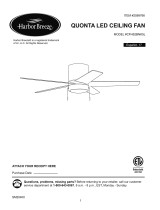 Harbor Breeze CFH52BNK5L Guía de instalación
Harbor Breeze CFH52BNK5L Guía de instalación
-
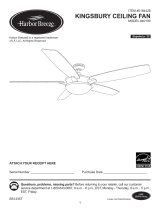 Harbor Breeze KINGSBURY 40190 Guía de instalación
Harbor Breeze KINGSBURY 40190 Guía de instalación
-
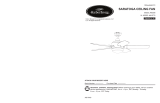 Harbor Breeze 00598 Guía de instalación
Harbor Breeze 00598 Guía de instalación
-
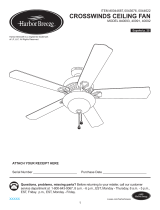 Harbor Breeze 40093 Manual de usuario
Harbor Breeze 40093 Manual de usuario
-
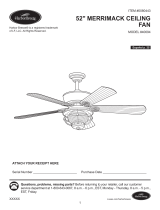 Harbor Breeze 0080443 Manual de usuario
Harbor Breeze 0080443 Manual de usuario
-
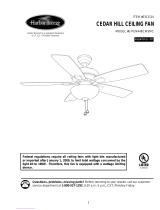 Harbor Breeze CEDAR HILL Guía de instalación
Harbor Breeze CEDAR HILL Guía de instalación
-
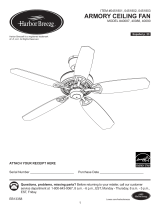 Harbor Breeze ARMORY 40088 Guía de instalación
Harbor Breeze ARMORY 40088 Guía de instalación
-
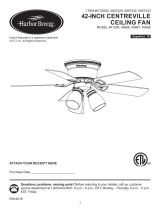 Harbor Breeze 40689 Guía de instalación
Harbor Breeze 40689 Guía de instalación
-
Harbor Breeze 40706 Guía de instalación
Otros documentos
-
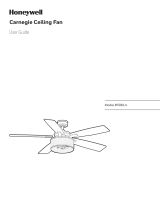 Honeywell Ceiling Fans 50614-01 Guía del usuario
Honeywell Ceiling Fans 50614-01 Guía del usuario
-
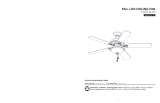 Brightwatts 52-CRB Manual de usuario
Brightwatts 52-CRB Manual de usuario
-
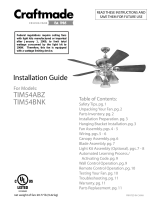 Craftmade TIM54ABZ Guía de instalación
Craftmade TIM54ABZ Guía de instalación
-
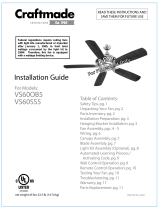 Craftmade CA60 Guía de instalación
Craftmade CA60 Guía de instalación
-
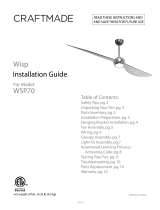 Craftmade Wisp WSP70 Guía de instalación
Craftmade Wisp WSP70 Guía de instalación
-
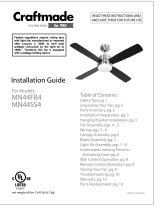 Craftmade MN44FB4 Guía de instalación
Craftmade MN44FB4 Guía de instalación
-
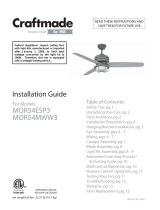 Craftmade MOR54MWW3 Guía de instalación
Craftmade MOR54MWW3 Guía de instalación
-
Portfolio SLC12BK Guía de instalación
-
Portfolio SL10W Guía de instalación
-
GE 20673 Guía de instalación
























































